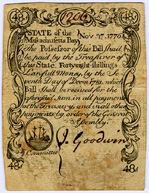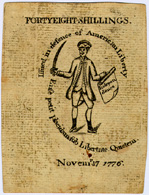Massachusetts Currency
November 17, 1776 - Sword in hand
An emission of £70,038 in legal tender bills of credit engraved and printed by Paul Revere in Boston. This emission was combined from two acts, on October 29, 1776 a total of £50,004 in bills was authorized. This was the original act for which Revere prepared the plates; however it was supplemented by an act of December 6, 1776 which provided for an additional £20,034 in bills to be printed using the same plates with the November 17, 1776 date. Together, this two part emission, was the fourth and final emission of notes by Revere in his series featuring an American soldier on the back, often called the "Sword in hand" issues. Approximately 6,485 bills were issued for each denomination in this emission and were redeemable in "Lawfull Money" on December 7, 1781. However this emission as well as all bills of 6s or higher from previous emissions were recalled for exchange by an act of October 13, 1777, which was amended three times, successively extending the date for redemption until December 1, 1778, at which time the notes became invalid and unredeemable.The front of each note has a small oval vignette with a ship docked at a harbor or a tree; the design differs on each denomination. The back depicts a colonial American soldier (sometimes called a minuteman) with a sword in his right hand and a copy of the Declaration of Independence in his left. Above is the motto "Issued in defence of American Liberty" and below is the motto of Massachusetts "Ense petit placidam sub Libertate Quietem." (By the sword one seeks peace under tranquil liberty).
The copper plates were the same ones used for the earlier issues of this series but with some significant alterations. Naturally, for each emission the dating was modified by rubbing out the date etched into the copper plate and replacing it with the proper date for the new emission. With the third emission of this series, on September 17, 1776, the word "Colony" on the front of the notes (appearing twice) was rubbed out and replaced with "State". In the present fourth emission the plates were further altered. In all previous emissions the document held by the soldier on the reverse read, "MAGNA CHARTA" referring to the document signed by King John in 1215, popularly interpreted as conferring rights to all free Englishmen. For this final emission, printed some four months after the signing of the Declaration of Independence, the wording on the document was rubbed off and replaced with "Independance." The misspelling is found on all denominations and is usually divided in two lines Indepen/dance except on the 28s note where it is in three lines. The copper plate for the back of these notes is extant in the Massachusetts State Archives. It was the reused reverse side of the plate originally used for Revere's large print issued in 1770, "A View of Part of the Town of Boston in New-England and British Ships of War Landing their Troops! 1768."
Paul Revere's original invoice, containing the charges for both the September and November emissions, is preserved in the Chamberlain Collection in the Boston Public Library. Next to the date Nov'r 17 is a charge for £8 "To engraving two plates anew" (refering to the modifications made to the plates for the November issue) and for £41 3s1 and 1/2d for printing 37,040 bills at 2d Old Tenor per bill. This reflected only the first part of the November emission authorized on October 29th. The invoice was submitted on December 30, 1776 and Revere was paid by the state on January 2, 1777. I assume the December 6th supplement had not been completed and that another invoice, that has not survived, was submitted at a later date for the 14,840 notes printed as the second part of this emission.
Denominations for the December 7, 1775 issue were the same as in the third issue: 10s, 14s, 16s, 22s, 28s, 36s, 42s and 48s. In this issue the only denomination with a known counterfeit is the 48s note.
obv
 rev
rev 
48s Counterfeit Serial Number: 1206 MA 11/17/76
Signers: Ichabod Goodwin (forgery).
Size: 111 x 76.5mm (front border design: 89 x 71mm)
Comments: The oval vignette differs somewhat on each denomination. On this denomination is a ship with an anchor in the water. The back depicts a colonial American soldier with a sword in his right hand and a copy of the Declaration of Independence in his left, identified by the misspelled word "Indepen/dance". Above is the motto, "Issued in defence of American Liberty" and below is the motto of Massachusetts, "Ense petit placidam sub Libertate Quietem" (By the sword one seeks peace under tranquil liberty). See the general discussion above for difference between this emission and prior emissions in this series.
This example is a well preserved contemporary counterfeit of the 48s note. The counterfeiter made a very close copy with only the following small differences from the legal issue. On the front in the corners the bottom of the 4 in the denomination is slightly higher that the bottom of the 8. Also, in the vignette the counterfeit lacks the fine lines representing ropes extending from the mast poles down to the deck, which are found on the originals. Finally, on the front the right border is 87mm from the top of the design to the bottom of the 8 while the left border is 89mm. There are no noticeable differences from the originals on the back.
Provenance: EAHA mail bid auction 4/26/96 lot 244. Purchased through the Robert H. Gore, Jr. Numismatic Endowment.